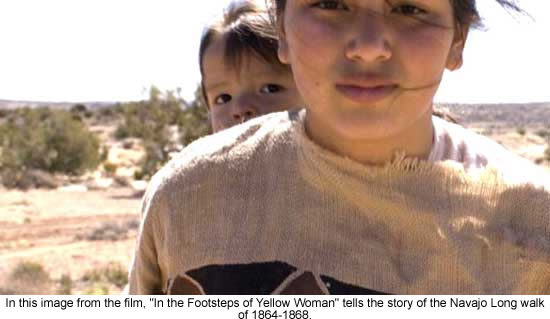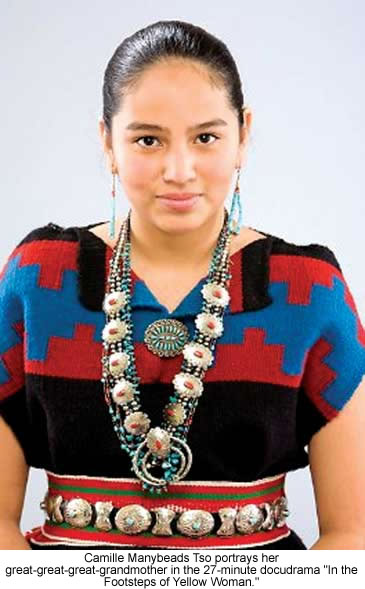 |
Canku Ota
|
 |
|
(Many Paths)
|
||
|
An Online Newsletter
Celebrating Native America
|
||
|
November 1, 2009 - Volume
7 Number 11
|
||
|
|
||
|
Navajo Girl Shares
Family's Dramatic Heritage
|
||
|
by Paula Rhoden - The
Prescott, AZ Daily Courier
|
||
|
credits: photos courtesy
of Outta Your Backpack Media (OYBMedia) oybm.org
|
|
One hundred and forty-five years later, another young Navajo woman walked in the footsteps of Yellow Woman, her great-great-great-grandmother. Camille
Manybeads Tso is a 14-year-old freshman at the Flagstaff Arts and
Leadership Academy. Home-schooled until she enrolled in FALA, Camille
used the skills she learned from an Outta Your Backpack Media Native
American youth workshop to make a 27-minute docudrama, "In
the Footsteps of Yellow Woman." Camille tells the story of Yellow Woman by interviewing her grandmother in Black Mesa and reenacting Yellow Woman's struggle to avoid relocation. The story begins with Yellow Woman at about age 14, hiding her baby daughter in a tree while she fled on horseback to lead the soldiers away from her family. When it was safe, she returned to find her daughter safe in the tree where she had placed her. Despite her efforts to remain strong for her family, the soldiers eventually caught up to Yellow Woman. Even though she was pregnant, the soldiers shot her and beat her, leaving her for dead. She lost her baby, but Yellow Woman lived. Eventually, she gave up her struggle and joined with other members of the tribe for the infamous Long Walk of the Navajos to Ft. Sumner. Beginning in 1864, the Navajo people walked 634 miles to Ft. Sumner. It took them two months to reach the fort and about 3,000 Navajos died either on the march or at the fort. Many Navajo elders and babies were lost crossing the Rio Grande River. The Navajos' confinement at Ft. Sumner ended in 1868 when the U.S. government allowed them to return home.
The film fit perfectly with what the students are studying: The freshmen are learning about displaced people and the sophomores are researching racism. Sophomore Sidney Faughn said he had learned about the Navajo Long Walk in the eighth grade. He said Camille's film was "powerful. It brought the story to life." As much as possible, Camille filmed "on locations where the events happened," she said. A trip to the Rio Grande was out of the question, so Camille substituted a river near Grand Falls in Northern Arizona. Camille said she spent about a year working on the film. "You never really think about your ancestors. Yellow Woman just wanted to protect her family and land," Camille said. "The fact is, she was probably about my age and the main caretaker of her family." Camille recruited members of her family, all descendents of Yellow Woman, to help her make costumes, direct, film, act, sing and edit. What started as a class project ended in an incredible journey to learn the history of her family, especially Yellow Woman. Camilla began working with the Outta Your Backpack Indigenous Youth media literacy collective when she was 9 years old. She is currently its youngest youth mentor. |
|
|
||
|
|
||
| Canku Ota is a free Newsletter celebrating Native America, its traditions and accomplishments . We do not provide subscriber or visitor names to anyone. Some articles presented in Canku Ota may contain copyright material. We have received appropriate permissions for republishing any articles. Material appearing here is distributed without profit or monetary gain to those who have expressed an interest. This is in accordance with Title 17 U.S.C. Section 107. | ||
|
Canku Ota is a copyright ©
2000, 2001, 2002, 2003, 2004, 2005, 2006, 2007, 2008, 2009 of Vicki
Barry and Paul Barry.
|
||
 |
 |
|
|
The "Canku
Ota - A Newsletter Celebrating Native America" web site and
its design is the
|
||
|
Copyright ©
1999, 2000, 2001, 2002, 2003, 2004, 2005,
2006, 2007, 2008, 2009 of Paul
C. Barry.
|
||
|
All Rights Reserved.
|
||
 In
1864, a young Navajo woman living in Black Mesa, Ariz., fought to
protect her family from the efforts of the U.S. Army and scout Kit
Carson to remove them from their land and send them to Ft. Sumner,
N.M.
In
1864, a young Navajo woman living in Black Mesa, Ariz., fought to
protect her family from the efforts of the U.S. Army and scout Kit
Carson to remove them from their land and send them to Ft. Sumner,
N.M. Camille
screened her film for freshman and sophomores at Northpoint Expeditionary
Learning Academy in Prescott on Sept. 25.
Camille
screened her film for freshman and sophomores at Northpoint Expeditionary
Learning Academy in Prescott on Sept. 25.